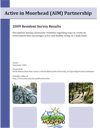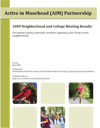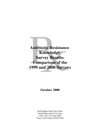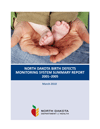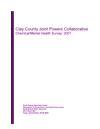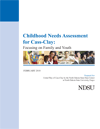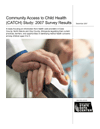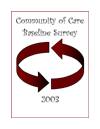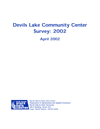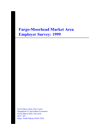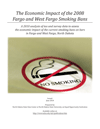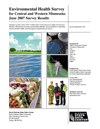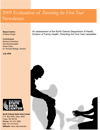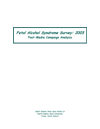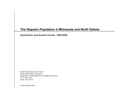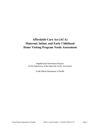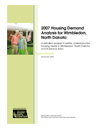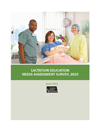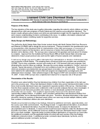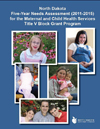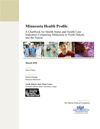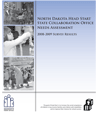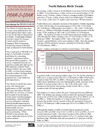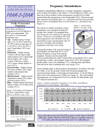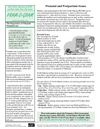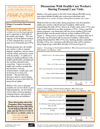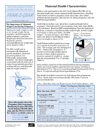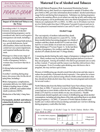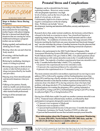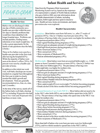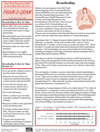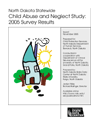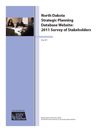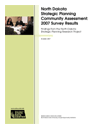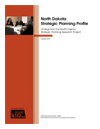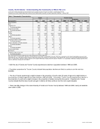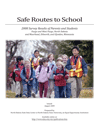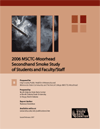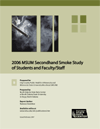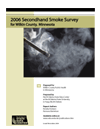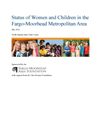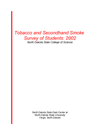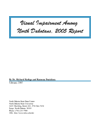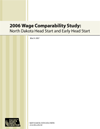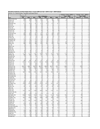The North Dakota State Data Center (NDSDC) at NDSU is no longer operational as of December 31, 2011. Research and other relevant publications conducted under the auspices of the North Dakota State Data Center (NDSDC) at NDSU are archived here. The research staff of what was formerly the NDSDC transitioned in January 2012 and continue their ongoing research as part of the Center for Social Research at NDSU. Former Director, Dr. Richard Rathge, retired in August 2013 after 32 years at NDSU.
Note: The Census Bureau-related functions of the former NDSDC at NDSU have transitioned to the North Dakota Census Office at the North Dakota Department of Commerce.
Select a publication category:

Research
Publications - IN CHRONOLOGICAL ORDER
- North Dakota Legislative Leadership Institute Presentation (2011)
- Minnesota SHIP Project - County Reports (2011)
- Status of Women and Children (2011)
- North Dakota Strategic Planning Project - Database Website Survey (2011)
- Minnesota SHIP Project - Community Active Living Surveys (2011)
- Lactation Education Needs Assessment (2011)
- Home Visiting Program Needs Assessment (posted April 2011)
- Maternal and Child Health Services Needs Assessment (posted April 2011)
- Community of Care (2003; 2011)
- Minnesota SHIP Project - Safe Routes to School Surveys (2010)
- Economic Impact of the 2008 Fargo and West Fargo Smoking Bans Study (2010)
- Nonprofit Sector Study - Minnesota (2010)
- North Dakota Head Start Needs Assessment (2010)
- Minnesota Health Profile (2010)
- Birth Defects Study (2010)
- Childhood Needs Assessment for Cass-Clay (2010)
- Active in Moorhead (AIM) Partnership Research (2009)
- Safe Routes to School Study in Fargo and West Fargo, North Dakota, and Moorhead, Dilworth, and Glyndon, Minnesota (2009)
- Evaluation of Parenting the First Year Newsletter (2009)
- North Dakota Head Start Needs Assessment (2009)
- Nonprofit Sector Study - North Dakota (2009)
- North Dakota PRAMS - Pregnancy Risk Assessment Monitoring System (2007-2008, 2004)
- Licensed Child Care Dismissal Study (2007, revised 2008)
- Community Alcohol Readiness Study (2001; 2008)
- Community Access to Child Health (CATCH) Study (2007)
- North Dakota KIDS COUNT (on-going)
- Housing Demand Analysis for Wimbledon, North Dakota (2007)
- North Dakota Strategic Planning Project - Community Assessment (2007)
- North Dakota Strategic Planning Project - Profile (2007)
- Environmental Health Survey for Central and Western Minnesota: June 2007 Survey Results (2007)
- Wage Comparability Study for North Dakota Head Start (2007)
- Secondhand Smoke Study of Students and Faculty/Staff: MSUM (2007)
- Secondhand Smoke Study of Students and Faculty/Staff: MSCTC-Moorhead (2007)
- Economic Impact of the Senior Population on North Dakota's Economy (2007)
- Northwest Area Foundation
Horizons Program Community Profiles (2007, 2004)
- Great Plains Population Projections (2006)
- Secondhand
Smoke Survey for Wilkin County, Minnesota (2006)
- Secondhand
Smoke Survey for Otter Tail County, Minnesota (2006)
- Academic Computing Long-Range Planning
(2006)
- Women's Way
Direct Mail Project (2005)
- North Dakota
Statewide Child Abuse and Neglect Study (2005)
- Otter Tail County,
Minnesota, Community Needs Assessment (2005)
- Wishek, North Dakota,
Surveys (2005)
- City of Moorhead, Minnesota,
Follow-up Tobacco Study (2005)
- Great Plains Policy Brief (2005)
- Secondhand Smoke Survey
for Central and Western Minnesota (2005)
- Hearing Impairment Among
North Dakotans (2005)
- Visual Impairment Among
North Dakotans (2005)
- North Dakota Statewide
Housing Needs Assessment (2004)
- North Dakota Employer Survey
(2003)
- Fetal Alcohol Syndrome Study (2003)
- Tobacco Studies 2002 - Households
(2003)
- Tobacco Studies 2002 - North Dakota
State College of Science (2003)
- Tobacco Studies 2002 - North Dakota State
University (2003)
- Informal Caregiving Research:
Grandparents as Caregivers (2003)
- Informal Caregiving Research:
Informal Caregivers (2003)
- Informal Caregiving Research:
Needs Assessment of Long Term Care (2002)
- North Dakota County
Migration Flows (2002)
- North Dakota Population
Projections (2002)
- Devils Lake Community Center Survey (2002)
- Demographics of the Great
Plains (2001-2002)
- Chemical/Mental Health Survey (2001)
- Hispanic Population in Minnesota and
North Dakota (2001)
- Economic Development Reports: College
Students (2000-2001)
- Economic Development Reports: Employer
and Labor Force (2000-2001)
- Antibiotic Resistance Knowledge Study (2000)
- Healthy Roads Media
(on-going)
- Archive:
| |
Highlights
of the Academic Computing Long-Range Planning Survey (January
2006) (116 KB, 22 pages) |
| This
report offers highlights of a survey conducted by the Computing
and Information Technologies Planning and Goals (CITPG) Committee
at North Dakota State University (NDSU) in November and December
2005. The results provide insight into what faculty members
see as the major academic computing concerns facing NDSU and
how to prioritize topics relating to those concerns. |
Active in Moorhead (AIM) Partnership
|
Active in Moorhead (AIM) Partnership: 2009 Resident Survey Results (September
2009) (1.77 MB, 78 pages) |
| The purpose of this study is to increase the understanding of Moorhead residents’ behaviors, attitudes, and perceptions
associated with active living in the City of Moorhead.
The AIM partnership, a partnership between Clay County Public Health, the City of Moorhead, and the
Fargo-Moorhead Metropolitan Council of Governments (Metro COG), is exploring how the city of
Moorhead can create an environment that encourages its residents to become active and stay active
through choices in their daily routines. The AIM partnership received funding for this study from Blue
Cross Blue Shield of Minnesota, who also is encouraging a lifestyle that integrates physical activity into
daily lives. |
|
Active in Moorhead (AIM) Partnership: 2009 Neighborhood and College Meeting Results (May
2009) (829 KB, 64 pages) |
| This report presents findings from a series of neighborhood and college meetings in Moorhead, Minnesota, conducted between January and March 2009 conducted by the AIM partnership. The purpose of the meetings was to gather information from residents regarding activing living and life in their neigbhorhoods. |
Antibiotic Resistance Knowledge Study
|
Antibiotic Resistance Knowledge Survey Results: Comparison of the 1999 and 2000 Surveys (October
2000) (726 KB, 79 pages) |
This publication features the comparison of findings from two surveys of residents of the Fargo/Moorhead metropolitan area (Fall 1999 baseline and Fall 2000). The surveys assessed residents' knowledge, attitudes, practices, and beliefs regarding antibiotics resistance. The follow-up 2000 survey was conducted to assess the effects of a comprehensive educational campaign. |
Birth Defects Study
|
North Dakota Birth Defects Monitoring System Summary Report 2001-2005 (March 2010) (6.33 MB, 111 pages) |
This publication presents an analysis of birth defects in North Dakota from 2001 through 2005. In addition to this analysis, information regarding population characteristics for North Dakota also is provided, as well as characteristics of live births, pregnancy, and death data. -Revised version with corrected definition of fetal death (pgs. 17, 23, and 24), corrected proportions/descriptions (pgs. 27, 50, 58), and higher resolution posted 9/20/2011 |
Chemical/Mental Health Survey
Childhood Needs Assessment for Cass-Clay
|
Childhood Needs Assessment for Cass-Clay: Focusing on Family and Youth (February 2010) (2.42 MB, 81 pages) |
The purpose of this report was to provide an assessment of the needs of people within the Fargo-Moorhead (F/M) metropolitan area in order to provide context for the United Way of Cass-Clay (UWCC)
and their strategic planning process.
- View related Presentation on "Cass-Clay Needs Assessment: Focus on Families and Youth" (March 2010)
|
City of
Moorhead, Minnesota, Follow-up Tobacco Study
Community Access to Child Health (CATCH) Study
|
Community
Access to Child Health (CATCH) Study: 2007 Survey Results (December 2007) (1.19 MB,
54 pages) |
This study focuses on information from health care providers in Cass County, North Dakota, and Clay County, Minnesota, regarding their current practices, barriers, and opportunities in identifying mental health concerns among children ages 0 to 5. Funding was provided by the 2007 Community Access to Child Health (CATCH) planning grant through the American Academy of Pediatrics. The goal of the CATCH grant is for all children in all communities to have a medical home and other necessary services in order to reach optimal health and well-being.
|
Community Alcohol Readiness Study
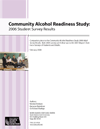 |
Community Alcohol Readiness Study: 2006 Student Survey Results (February 2008) (8.89 MB, 80 pages) |
This report presents the results of the 2006 survey of students in grades 7 through 12 in the Fargo Public School District. As part of the Community Alcohol Readiness study, the purpose of the research is to increase understanding of students' and adults' attitudes and perceptions associated with underage drinking and to provide objective data that can be used by decision makers to explore strategies to combat underage drinking.
|
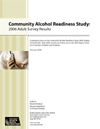 |
Community Alcohol Readiness Study: 2006 Adult Survey Results (February 2008) (3.68 MB, 106 pages) |
This report presents the results of the 2006 survey of adults in Fargo, North Dakota. As part of the Community Alcohol Readiness study, the purpose of the research is to increase understanding of students' and adults' attitudes and perceptions associated with underage drinking and to provide objective data that can be used by decision makers to explore strategies to combat underage drinking.
|
Community of Care
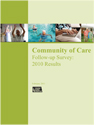 |
Community of Care Follow-Up Survey: 2010 Results (February 2011) (2.4 MB, 39 pages) |
| This report, entitled Community of Care Follow-up Survey: 2010 Results, presents findings of a survey of
residents of rural Cass County North Dakota regarding perceptions and attitudes related to meeting the
needs of seniors and disabled persons. The report also compares the 2010 results to the baseline survey
results gathered in 2003. |
| |
Community
of Care Baseline Survey: 2003 (February 2004) (1.37 MB,
74 pages) |
|
The Cass County Community of Care is a project designed by
the Good Samaritan Society to establish a permanent community-based
system of care. Their mission is to ensure access to services
for all seniors and disabled persons throughout rural Cass
County. This system of care, if successful in rural Cass County,
North Dakota, will be implemented throughout the United States
where Good Samaritan Centers are located. In an effort to
assist in determining success, a survey of rural Cass County
residents was conducted to provide a baseline of knowledge
and attitudes pertaining to services, funding, and perceptions
of community responsibility for the care of seniors and disabled
persons. The results of that survey are the focus of this
report.
|
Demographics of the Great Plains
| |
Demographic
Chartbook: Profiling Change in the Great Plains (October
2001) (17.7 MB, 56 pages) |
This
study is part of a larger research and policy effort to advance
understanding and viability of the Great Plains. These research
findings served as the foundation for the Great
Plains Population Symposium aimed at raising national
awareness and corresponding policy debate. View/download any
of the following individual sections within the document:
|
|
View related products:
|
Devils Lake Community Center Survey
|
Devils Lake Community Center Survey: 2002 (April 2002) (1.32 MB, 57 pages) |
The purpose of this study was to learn more about residents' interests in and the utilization of a possible community center in Devils Lake, North Dakota. |
Economic
Development Reports: College Students
| |
Student
Focus Groups: 2001 (May 2001) (352 KB, 34 pages) |
|
This report is part of a series of labor force studies sponsored
by the Fargo-Cass County Economic Development Corporation,
Moorhead Economic Development Authority and the Valley City-Barnes
County Economic Development Corporation through the cooperation
of a locally driven regional Labor Availability Council. This
report details the findings from a series of focus groups
conducted with students graduating from post-high school degree
and certificate granting institutions within 60 miles of Fargo/Moorhead
in the Spring of 2001.
|
| |
Market
Area Student Survey: 2000 (January 2000) (1.0 MB, 45 pages) |
| The
purpose of this project was to provide information about students’
attitudes regarding employment preferences, training and skills
development, employer incentives and benefit packages, and issues
related to commuting and future mobility. This report is part
of a series of labor force studies sponsored by the Fargo-Cass
County Economic Development Corporation, Moorhead Economic Development
Authority and the Valley City-Barnes County Economic Development
Corporation through the cooperation of a locally driven regional
Labor Availability Council. |
Economic
Development Reports: Employer and Labor Force
Economic Impact of the 2008 Fargo and West Fargo Smoking Bans Study
|
The Economic Impact of the 2008 Fargo and West Fargo Smoking Bans: A 2010 analysis of tax and survey data to assess the economic impact of the current smoking bans on bars in Fargo and West Fargo, North Dakota (June 2010)
(3.51 MB, 92 pages) |
The purpose of this project is to assess the economic impact of the July 1, 2008,
comprehensive smoking bans on businesses, specifically bars, within Fargo and West Fargo. Our approach was
threefold. First, we conducted a horizontal and vertical analysis of the Accommodation and Food
Services industries in Fargo, West Fargo, and Grand Forks. Second, we conducted a regression analysis
of the tax data for these industries in Fargo and West Fargo. These first two sections took a
macroeconomic approach and utilized tax data for Fargo and West Fargo. The city of Grand Forks,
which allowed smoking in bars at the time of our study, served as a benchmark for the horizontal and vertical analysis.
Third, we conducted a random survey of bar employees in Fargo and West Fargo to determine
perceptions of changes in drinking establishments in the last two years.
|
Economic Impact of the Senior Population on North Dakota's Economy
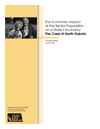
|
The Economic Impact of the Senior Population on a State's Economy: The Case of North Dakota (January 2007) (916 KB, 40 pages) |
This study addresses the changing age profile of North Dakota and the consequences it poses over
the next 15 years. In particular, it focuses on the rapidly growing elderly population in the state and its
impact on income generation. This is accomplished by using an economic simulation model to develop
scenarios of income generation in North Dakota based on historical patterns. In brief, the model was
designed to answer the question, “What will the distribution of income over the next 10 to 15 years look
like if the current pattern of age-specific earnings continues into the future unchanged?” The goal of this
research is to offer decision makers insight into how the state’s shifting age distribution will alter the type
of income that is generated and its corresponding consequences. It is hoped that these results will spur
debate and motivate policy makers to be proactive in finding innovative solutions that will mitigate the
negative impacts that are forecast. |
Environmental Health Survey
Evaluation of Parenting the First Year Newsletter
|
2009 Evaluation of Parenting the First Year Newsletter (July 2009) (568 KB, 35 pages) |
This report presents the findings from surveys
sent to new parents in North Dakota. The purpose of the
surveys was to gather information from new parents in North Dakota regarding the usefulness, appeal,
barriers, and preferences to reading the North Dakota Department of Health, Division of Family Health,
Parenting the First Year newsletter. The findings presented in this report will be used by the North Dakota
Department of Health, Division of Family Health, to make informed decisions to improve the publication. |
Fetal Alcohol Syndrome Study
Great
Plains Policy Brief
Great
Plains Population Projections
Research support for the Great Plains Population Projections comes from the USDA North Dakota Rural Development Center and regional research project W1001. Data come from 12 State Demographic Units, and cover age-cohorts by county type from 2000 through 2020.
See related presentation The Demographic Future of the Great Plains presented at the annual meeting of the Rural Sociological Society, Louisville, KY
A published journal article is pending, and will be posted as soon as it is available.
|
Healthy
Roads Media
 |
To access health information
or learn more about the project, visit the Healthy
Roads Media Website. Click here to a view a two-page brochure
about Healthy Roads Media. |
| Healthy
Roads Media provides information about a variety of health
care topics (such as asthma, cancer, dental care, diabetes,
nutrition, smoking, and women's health). The materials are
presented in a variety of formats (audio, written, multimedia,
and web page video) and in a number of languages (English,
Spanish, Vietnamese, Arabic, Somali, Bosnian, Russian, Hmong,
and Khmer). The North Dakota State Data Center is helping
to assess the value of these formats in providing health information
for diverse populations. |
Hearing Impairment
Among North Dakotans
| |
Hearing
Impairment Among North Dakotans, 2005 Report (March 2005)
(2.6 MB, 25 pages) |
|
The purpose of this report is to present estimates and projections
of the number of people ages 15 and older in North Dakota
who have a hearing impairment, in 2000, 2010, and 2015. |
Hispanic
Population in Minnesota and North Dakota
| |
The
Hispanic Population in Minnesota and North Dakota: Distribution
and Growth Trends: 1990-2000 (October 2001) (1.7 MB, 31
pages) |
|
This report was part of a project sponsored by Migrant Health
Services, Inc., of Moorhead, Minnesota. An important goal
of this project was to estimate the distribution of migrant
farm workers and their families in the states of Minnesota
and North Dakota. The intent of the project was to serve as
a starting point for a larger effort aimed at surveying the
needs of migrant farm workers and their families and to gain
insight into where they receive their services. |
Home Visiting Program Needs Assessment
Housing Demand Analysis for Wimbledon, North Dakota
|
2007 Housing Demand Analysis for Wimbledon, North Dakota (November 2007)
(800 KB, 53 pages) |
A detailed housing analysis was conducted for the Wimbledon Housing and Redevelopment Authority to determine future housing needs within the community and its surrounding community service area. The report includes historical demographic and economic trends, projections from a housing forecast model, results of a generalizable housing survey of residents, and recommendations for future housing development strategies.
|
Informal
Caregiving Research: Grandparents as Caregivers
 |
Grandparents
as Caregivers in North Dakota, 2002: Outreach and Phone Surveys
(June 2003) (1.91 MB, 126 pages) |
Includes
data collected from a combination of 80 face-to-face interviews
and 26 phone interviews with grandparent caregivers; sections
include: an introduction, a set of recommendations, and survey
results.
This project was made possible through a combined effort
between the North Dakota State Data Center at North Dakota
State University (NDSU), the Child Development and Family
Science Department at NDSU, the North Dakota Center for Rural
Health at the University of North Dakota (UND), and the North
Dakota Department of Human Services (ND DHS), Aging Services
Division. |
Informal
Caregiving Research: Informal Caregivers
 |
Informal
Caregivers: 2002 - Outreach Survey (May 2003) (2.12 MB,
118 pages) |
| Includes
data collected from 652 face-to-face interviews with informal
caregivers; sections include: an introduction, a set of recommendations,
survey results, and information about significant differences
in the data by caregiver relationship.
This project was made possible through a combined effort
between the North Dakota State Data Center at North Dakota
State University (NDSU), the Child Development and Family
Science Department at NDSU, the North Dakota Center for Rural
Health at the University of North Dakota (UND), and the North
Dakota Department of Human Services (ND DHS), Aging Services
Division. |
Informal
Caregiving Research: Needs Assessment of Long Term Care
 |
Needs
Assessment of Long Term Care, North Dakota: 2002 - Initial Report
and Policy Recommendations (November 2002) (9.55 MB, 242
pages) |
Report
was compiled in response to a request from the North Dakota
State Legislature for an initial report of activities and
a set of policy recommendations regarding long term care in
North Dakota; purpose of this project was to assess the current
and future long term care needs of residents in North Dakota;
this report summarizes contributions by the North Dakota State
Data Center at North Dakota State University, Fargo, ND, and
the Center for Rural Health at the University of North Dakota,
Grand Forks, ND. View/download any of the following individual
sections within the document:
|
|
This project was made possible through a combined effort
between the North Dakota State Data Center at North Dakota
State University (NDSU), the Child Development and Family
Science Department at NDSU, the North Dakota Center for Rural
Health at the University of North Dakota (UND), and the North
Dakota Department of Human Services (ND DHS), Aging Services
Division. It was funded through an appropriation under the
Older Americans Act, Title III, Part E, National Family Caregiver
Support Program and administered through the North Dakota
Department of Human Services, Aging Services Division.
For more information on this project,
visit:
|
Lactation Education Needs Assessment
|
Lactation Education Needs Assessment Survey, 2010
(April 2011) (2.6 MB, 43 pages) |
The purpose of this study was to determine whether there is a need for lactation education opportunities
in the tri-state area of Minnesota, North Dakota, and South Dakota. The study also looked at attitudes,
perceptions, and barriers regarding lactation education. A market analysis, with a focus on further
exploration of needs and barriers for lactation education, is also included in this report. Data were collected in December 2010. This study was made possible by a grant from the Minnesota Department of Health Statewide Health
Improvement Program. The study was conducted by the North Dakota State Data Center (NDSDC) on
behalf of Otter Tail County Public Health in Minnesota. |
Licensed Child Care Dismissal Study
|
Licensed Child Care Dismissal Study
(October
2007, revised May 2008) (778 KB, 35 pages) |
Presents results of a September 2007 survey of licensed child care providers in North Dakota conducted for North Dakota Child Care Resource and Referral. The study was designed to gather information regarding the extent to which children are dismissed from child care programs in North Dakota and the reasons surrounding their dismissal. The results will give policy makers and child care administrators insight into the magnitude of the issue and a clearer understanding of what is contributing to the issue. Information will also assist decision makers in defining needs for supportive services.
|
Maternal and Child Health Services Needs Assessment
|
North Dakota Five-Year Needs Assessment (2011-2015) for the Maternal and Child Health Services Title V Block Grant Program (Posted April 2011) (6.64 MB, 204 pages) |
The North Dakota Five-Year Needs Assessment (2011-2015) for the Maternal and Child Health Services Title V Block Grant Program is a publication of the ND Department of Health for the Division of Children's Special Health Services, Division of Family Health, Division of Nutrition and Physical Activity, and the Division of Injury Prevention and Control. The North Dakota State Data Center was responsible for analyzing and presenting the data in the section entitled "Strengths and Needs of the Maternal and Child Health Population Groups and Desired Outcomes," from pgs. 36-154.
|
Minnesota Health Profile
|
Minnesota Health Profile: A Chartbook for Health Status and Health Care Indicators Comparing Minnesota to North Dakota and the Nation (March 2010) (.97 MB, 39 pages) |
This report serves as a brief overview of the health status of Minnesotans and the quality of health care within the state. It was designed as a comparative tool, thus information also is provided for the neighboring state of North Dakota and the nation. The primary purpose of the document is to offer decision makers a contextual snapshot of current health circumstances within the state and the corresponding environment in which health care is delivered.
- View only the Tables of the Minnesota Health Profile Report (March 2010)
|
Minnesota SHIP Project - Community Active Living Surveys
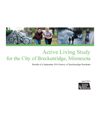
|
Active Living Study for the City of Breckenridge, Minnesota: Results of a September 2010 Survey of Breckenridge Residents (April 2011) (1.4 MB, 38 pages) |
The key objective of this study was for the Becker, Clay, Otter Tail, and Wilkin County Minnesota Statewide Health Improvement Program (SHIP) to
explore ways in which the City of Breckenridge can create an environment that encourages its residents to
become and stay active through choices in their daily routines. |
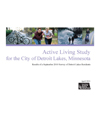
|
Active Living Study for the City of Detroit Lakes, Minnesota: Results of a September 2010 Survey of Detroit Lakes Residents (April 2011) (1.4 MB, 42 pages) |
The key objective of this study was for the Becker, Clay, Otter Tail, and Wilkin County Minnesota Statewide Health Improvement Program (SHIP) to
explore ways in which the City of Detroit Lakes can create an environment that encourages its residents to
become and stay active through choices in their daily routines. |
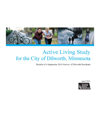
|
Active Living Study for the City of Dilworth, Minnesota: Results of a September 2010 Survey of Dilworth Residents (April 2011) (1.3 MB, 38 pages) |
The key objective of this study was for the Becker, Clay, Otter Tail, and Wilkin County Minnesota Statewide Health Improvement Program (SHIP) to
explore ways in which the City of Dilworth can create an environment that encourages its residents to
become and stay active through choices in their daily routines. |
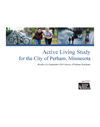
|
Active Living Study for the City of Perham, Minnesota: Results of a September 2010 Survey of Perham Residents (April 2011) (1.3 MB, 37 pages) |
The key objective of this study was for the Becker, Clay, Otter Tail, and Wilkin County Minnesota Statewide Health Improvement Program (SHIP) to
explore ways in which the City of Perham can create an environment that encourages its residents to
become and stay active through choices in their daily routines. |
Minnesota SHIP Project - County Reports
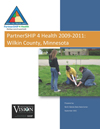
|
PartnerSHIP 4 Health 2009-2011: Wilkin County, Minnesota (September 2011) (2.1 MB, 33 pages) |
This report, “PartnerSHIP 4 Health 2009-2011: Wilkin County, Minnesota” is an evaluation of the five health initiatives that were implemented in Wilkin County, Minnesota, from June 2009 through June 2011. The initiatives studied are community and school physical activity, school nutrition, worksite wellness, and health care guideline implementation. |
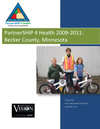
|
PartnerSHIP 4 Health 2009-2011: Becker County, Minnesota (September 2011) (1.9 MB, 34 pages) |
This report, “PartnerSHIP 4 Health 2009-2011: Becker County, Minnesota” is an evaluation of the five health initiatives that were implemented in Becker County, Minnesota, from June 2009 through June 2011. The initiatives studied are community and school physical activity, school nutrition, worksite wellness, and health care guideline implementation. |
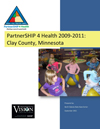
|
PartnerSHIP 4 Health 2009-2011: Clay County, Minnesota (September 2011) (1.9 MB, 33 pages) |
This report, “PartnerSHIP 4 Health 2009-2011: Clay County, Minnesota” is an evaluation of the five health initiatives that were implemented in Clay County, Minnesota, from June 2009 through June 2011. The initiatives studied are community and school physical activity, school nutrition, worksite wellness, and health care guideline implementation. |
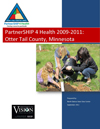
|
PartnerSHIP 4 Health 2009-2011: Otter Tail County, Minnesota (September 2011) (2.1 MB, 34 pages) |
This report, “PartnerSHIP 4 Health 2009-2011: Otter Tail County, Minnesota” is an evaluation of the five health initiatives that were implemented in Otter Tail County, Minnesota, from June 2009 through June 2011. The initiatives studied are community and school physical activity, school nutrition, worksite wellness, and health care guideline implementation. |
Minnesota SHIP Project - Safe Routes to School Surveys
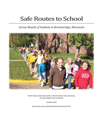
|
Safe Routes to School: Survey Results of Students in Breckenridge, Minnesota (October 2010) (.7 MB, 25 pages) |
The Safe Routes to School study is part of the Becker, Clay, Otter Tail, and Wilkin County Statewide Health Improvement Program (SHIP) initiative. The research findings presented in this report will give city leaders, policy makers, and school administrators in Breckenridge, MN, insight into student perceptions regarding safe routes to school and barriers that prevent students from walking or bicycling to and from school. |
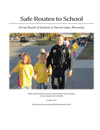
|
Safe Routes to School: Survey Results of Students in Detroit Lakes, Minnesota (October 2010) (.8 MB, 28 pages) |
The Safe Routes to School study is part of the Becker, Clay, Otter Tail, and Wilkin County Statewide Health Improvement Program (SHIP) initiative. The research findings presented in this report will give city leaders, policy makers, and school administrators in Detroit Lakes, MN, insight into student perceptions regarding safe routes to school and barriers that prevent students from walking or bicycling to and from school. |
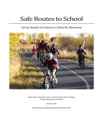
|
Safe Routes to School: Survey Results of Students in Dilworth, Minnesota (October 2010) (.7 MB, 25 pages) |
The Safe Routes to School study is part of the Becker, Clay, Otter Tail, and Wilkin County Statewide Health Improvement Program (SHIP) initiative. The research findings presented in this report will give city leaders, policy makers, and school administrators in Dilworth, MN, insight into student perceptions regarding safe routes to school and barriers that prevent students from walking or bicycling to and from school. |
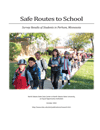
|
Safe Routes to School: Survey Results of Students in Perham, Minnesota (October 2010) (.7 MB, 17 pages) |
The Safe Routes to School study is part of the Becker, Clay, Otter Tail, and Wilkin County Statewide Health Improvement Program (SHIP) initiative. The research findings presented in this report will give city leaders, policy makers, and school administrators in Perham, MN, insight into student perceptions regarding safe routes to school and barriers that prevent students from walking or bicycling to and from school. |
Nonprofit Sector Study
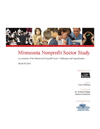
|
Minnesota Nonprofit Sector Study - An Analysis of the Minnesota Nonprofit Sector: Challenges and Opportunities (March 2010) (2.4 MB, 118 pages) |
The purpose of this project is to raise awareness of the impact of the nonprofit
sector in the state of Minnesota, to investigate where scarce resources are being dedicated
throughout the charitable sphere, and to determine if that investment is effectively and efficiently
delivered. This project also serves to guide
future efforts aimed at nonprofit sector performance improvement and to help the nonprofit sector
achieve the greatest possible societal impact within the state.
- View Briefing
Points of Study Results (March 2010)
- View related Presentation on "Nonprofit Sector in North Dakota: Challenges and Opportunities" - (April 2010)
|
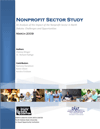
|
Nonprofit Sector Study - An Analysis of the Impact of the Nonprofit Sector in North Dakota: Challenges and Opportunities (March 2009) (2.0 MB, 99 pages) |
The purpose of this project is to raise awareness of the impact of the nonprofit
sector in the state of North Dakota, to investigate where scarce resources are being dedicated
throughout the charitable sphere, and to determine if that investment is effectively and efficiently
delivered. This project also serves to guide
future efforts aimed at nonprofit sector performance improvement and to help the nonprofit sector
achieve the greatest possible societal impact within the state.
- View Briefing
Points of Study Results (March 2009)
- View related Presentation on "The Impact of the Nonprofit Sector in North Dakota: Challenges and Opportunities" (March 2009)
|
North Dakota County Migration
Flows
North Dakota Employer Survey
| |
North
Dakota Employer Survey: 2003 (October 2003) (4.41 MB, 41
pages) |
|
Provides information regarding employers' attitudes and perceptions
of labor issues concerning the growth and development of primary-sector
businesses throughout North Dakota. |
North Dakota Head Start Needs Assessment
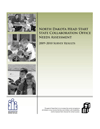 |
North
Dakota Head Start State Collaboration Office Needs Assessment: 2009-2010 Survey Results (April 2010) (2.28 MB, 103 pages) |
This report presents the results of the 2009-2010 needs assessment and is a follow-up to the
first study conducted in 2008-2009. This report presents findings from a survey of staff and directors representing 11 Head Start programs serving North Dakota children
and families for the school year 2009-2010. The purpose of the survey was to gather information for a site-based
assessment of Head Start programs with specific focus on cooperation, coordination, and collaboration within nine key
activity areas. |
|
North
Dakota Head Start State Collaboration Office Needs Assessment: 2008-2009 Survey Results (February 2009) (935 KB, 83 pages) |
This report presents findings from a survey of staff and directors representing 11 of the 14 Head Start programs in North Dakota for the school year 2008-2009. The purpose of the survey was to gather information for a site-based assessment of Head Start programs with specific focus on cooperation, coordination, and collaboration within nine key activity areas. |
North Dakota KIDS COUNT
| 
|
The North
Dakota KIDS COUNT Website provides resources for a great
deal of data and several publications. Collaboration on certain research efforts occurs between the North Dakota State Data Center and the North Dakota KIDS COUNT program. |
North Dakota Legislative Leadership Institute Presentation
|
The North Dakota Legislative Leadership Institute on Child Development Research and Policy was held in Bismarck, ND, September 12-14, 2011. The PowerPoint Presentation and accompanying Briefing Points on "The Well-Being of North Dakota's Infants and Toddlers" were presented at this institute. |
|
North Dakota Population
Projections
 |
North
Dakota Population Projections: 2005 to 2020 (September
2002) (3.99 MB, 120 pages)
(Updated May 2003: A correction to
the total of 40-44 year olds for 2015 has been made to the second
page of each profile. The online files have been updated to reflect
this correction.) |
Updated population projections for North Dakota were released
September of 2002 by the North Dakota State Data Center.
The results include population projections for North Dakota
(2005-2020) and each of its 53 counties, including distributions
by age and gender for 1980 through 2020. It includes historical
population trends as well as a discussion of leading population
trends and methodology regarding
how the projections were developed.
|
North Dakota PRAMS
- Pregnancy Risk Assessment Monitoring System
North
Dakota Statewide Child Abuse and Neglect Study
| |
North
Dakota Statewide Child Abuse and Neglect Study: 2005 Survey
Results (December 2005) (540 KB, 90 pages) |
|
This research focuses on gaining insight into residents'
attitudes and perceptions regarding child abuse and neglect
issues in North Dakota. It is a follow-up to a baseline public
opinion survey conducted in the spring of 2002. It is part
of a long range project aimed at monitoring child abuse and
neglect within the state, introducing initiatives to promote
positive change, and evaluating the impact of those initiatives.
|
North
Dakota Statewide Housing Needs Assessment
 |
The statewide housing
needs assessment was conducted by the North Dakota State
Data Center at North Dakota State University for the North
Dakota Housing Finance Agency and the North Dakota Department
of Commerce Division of Community Services. Results are
presented as a Final Report, as Detailed Tables, and through
the SHARP website and are available online.
|
View needs assessment products:
-
-
-
-
Supplements:
-
Related
Products:
|
North Dakota Strategic Planning Project
|
North Dakota Strategic Planning Database Website: 2011 Survey of Stakeholders (May 2011) (960 KB, 34
pages) |
| This report
presents findings of a survey of key stakeholders across North Dakota regarding the value of the pilot strategic
planning database that was created with the hope of enhancing the viability of communities through
cooperative ventures that nurture and promote resource sharing. The survey explored the perception of need for a database, the ability of the
database to increase collaboration, the usability of the database, and willingness to participate in the future. |
|
North
Dakota Strategic Planning Community Assessment: 2007 Survey Results - Findings from the North Dakota Strategic Planning Research Project (October 2007) (819 KB, 95
pages) |
Presents results of a survey to gather information from communities with less than 2,500 people across North Dakota about priorities and planning activities regarding four main strategic planning topics: Community Development, Economic Development, Natural Resources, and Emergency Management, as well as information about strategic planning barriers. |
|
North
Dakota Strategic Planning Profile - Findings from the North Dakota Strategic Planning Research Project (October 2007) (3.06 MB, 60
pages) |
| Presents the initial findings from the North Dakota strategic planning database. It provides a list of the communities currently involved in the research project along with the themes represented among the goals and objectives of each community's strategic plan. It also includes maps to aid in identifying the commonalities of themes among participating geographies across the state. This report also presents the findings of a short survey conducted in April 2007 designed to gain insight into the current status of the strategic plans in the database. |
Northwest Area Foundation Horizons
Program Community Profiles
| |
Six-page community profiles
were generated for the Northwest Area
Foundation Horizons Program to assist in understanding poverty. A total of 25 profiles generated in 2007 cover 21 communities and eight zip codes in North Dakota. A total of nine profiles generated in 2004 cover six North Dakota communities, two Minnesota communities, and one South Dakota community. |
- Table 1. Demographic Characteristics
- Table 2. Housing Characteristics
- Table 3. Income and Poverty Characteristics
- Table 4. Religious Congregation and Membership Characteristics
- Table 5. Health Characteristics
- Table 6. Labor Force Characteristics
- Table 7. Employment Characteristics
- Table 8. Educational
Attainment Characteristics
- Table 9. School District Characteristics
2007
- Cando, North Dakota - Understanding the Community
in Which We Live (January 2007) (70 KB, 6 pages)
- Cooperstown, North Dakota - Understanding the Community
in Which We Live (January 2007) (25 KB, 6 pages)
- Crosby, North Dakota - Understanding the Community
in Which We Live (January 2007) (25 KB, 6 pages)
- Grant County Communities (Carson-Elgin-New Leipzig), North Dakota - Understanding the Community
in Which We Live (January 2007) (26 KB, 6 pages)
- Harvey, North Dakota - Understanding the Community
in Which We Live (January 2007) (26 KB, 6 pages)
- Lidgerwood, North Dakota - Understanding the Community
in Which We Live (January 2007) (70 KB, 6 pages)
- Linton, North Dakota - Understanding the Community
in Which We Live (January 2007) (25 KB, 6 pages)
- Maddock, North Dakota - Understanding the Community
in Which We Live (January 2007) (26 KB, 6 pages)
- McKenzie County Communities (Alexander-Arnegard-Watford City), North Dakota - Understanding the Community
in Which We Live (January 2007) (71 KB, 6 pages)
- Mohall, North Dakota - Understanding the Community
in Which We Live (January 2007) (25 KB, 6 pages)
- New Town, North Dakota - Understanding the Community
in Which We Live (January 2007) (70 KB, 6 pages)
- Rolette, North Dakota - Understanding the Community
in Which We Live (January 2007) (26 KB, 6 pages)
- Rugby, North Dakota - Understanding the Community
in Which We Live (January 2007) (25 KB, 6 pages)
- Stanley, North Dakota - Understanding the Community
in Which We Live (January 2007) (26 KB, 6 pages)
- Steele, North Dakota - Understanding the Community
in Which We Live (January 2007) (25 KB, 6 pages)
- Towner, North Dakota - Understanding the Community
in Which We Live (January 2007) (25 KB, 6 pages)
- Walhalla, North Dakota - Understanding the Community
in Which We Live (January 2007) (25 KB, 6 pages)
- Zip Code 58067, North Dakota - Understanding the Community
in Which We Live (January 2007) (71 KB, 6 pages)
- Zip Code 58365, North Dakota - Understanding the Community
in Which We Live (January 2007) (26 KB, 6 pages)
- Zip Code 58374, North Dakota - Understanding the Community
in Which We Live (January 2007) (27 KB, 6 pages)
- Zip Code 58418, North Dakota - Understanding the Community
in Which We Live (January 2007) (72 KB, 6 pages)
- Zip Code 58442, North Dakota - Understanding the Community
in Which We Live (January 2007) (26 KB, 6 pages)
- Zip Code 58544, North Dakota - Understanding the Community
in Which We Live (January 2007) (26 KB, 6 pages)
- Zip Code 58625, North Dakota - Understanding the Community
in Which We Live (January 2007) (26 KB, 6 pages)
- Zip Code 58710, North Dakota - Understanding the Community
in Which We Live (January 2007) (26 KB, 6 pages)
2004
- Understanding the Community
in Which We Live: Ashley, North Dakota
(June 2004) (62 KB, 6 pages)
- Understanding the Community
in Which We Live: Bagley, Minnesota
(April 2004) (62 KB, 6 pages)
- Understanding the Community
in Which We Live: Beach, North Dakota
(June 2004) (61 KB, 6 pages)
- Understanding the
Community in Which We Live: Ellendale,
North Dakota (June 2004) (62 KB, 6 pages)
- Understanding the Community
in Which We Live: Eureka, South Dakota
(June 2004) (62 KB, 6 pages)
- Understanding the
Community in Which We Live: Grafton, North
Dakota (April 2004) (123 KB, 6 pages)
- Understanding the Community
in Which We Live: Mott, North Dakota
(June 2004) (60 KB, 6 pages)
- Understanding
the Community in Which We Live: Red Lake Falls,
Minnesota (April 2004) (123 KB, 6 pages)
- Understanding the Community
in Which We Live: Regent, North Dakota
(June 2004) (61 KB, 6 pages)
|
Otter
Tail County, Minnesota, Community Needs Assessment
| |
Otter
Tail County, Minnesota, Community Needs Assessment: 2005 Project
Summary (November 2005) (207 KB, 12 pages) |
|
Overall summary of activities conducted by t he North Dakota
State Data Center for the Otter Tail County Needs Assessment
Committee. |
 |
Otter
Tail County, Minnesota, Community Needs Assessment: 2005 Survey
Results (November 2005) (154 KB, 34 pages) |
| Perceptions
among key leaders regarding the most important issues facing
their community. |
 |
Otter
Tail County, Minnesota, Community Needs Assessment: 2004 Focus
Group Results (January 2005) (92 KB, 11 pages) |
| Perceptions
of priority among residents regarding housing, education, health
care, child care, transportation, and other program services. |
Safe Routes to School Study in Fargo and West Fargo, North Dakota, and Moorhead, Dilworth, and Glyndon, Minnesota
|
Safe Routes to School: 2008 Survey Results of Parents and Students, Fargo and West Fargo, North Dakota, and Moorhead, Dilworth, and Glyndon, Minnesota (August 2009) (3.86 MB, 152 pages) |
The research findings presented in this report will give city leaders, policy makers, and school
administrators insight into student and parent perceptions regarding safe routes to school and barriers
that prevent students from walking or bicycling to and from school. This study was designed as a
collaborative project intended to offer a city-wide perspective of all Fargo public schools. Through the
efforts and support of the Fargo-Moorhead Metropolitan Council of Governments (Metro COG), West
Fargo, Moorhead, Dilworth, and Glyndon public schools were included in the study. |
Secondhand Smoke Study of Students and Faculty/Staff: MSCTC-Moorhead (2007)
|
2006
MSCTC-Moorhead Secondhand Smoke Study of Students and Faculty/Staff (February 2007) (3.71 MB, 93 pages) |
This is one of two parts to a study commissioned by Clay County Public Health. Two surveys were conducted at the Moorhead campus of Minnesota State Community and Technical College(MSCTC-Moorhead) - one with students and one with faculty/staff. The study gathered information from the campus community regarding attitude and behaviors toward tobacco use and issues pertaining to smoking and secondhand smoke policies.
|
Secondhand Smoke Study of Students and Faculty/Staff: MSUM (2007)
|
2006
MSUM Secondhand Smoke Study of Students and Faculty/Staff (February 2007) (9.03 MB, 91 pages) |
This is one of two parts to a study commissioned by Clay County Public Health. Two surveys were conducted at Minnesota State University Moorhead (MSUM) - one with students and one with faculty/staff. The study gathered information from the campus community regarding attitude and behaviors toward tobacco use and issues pertaining to smoking and secondhand smoke policies.
|
Secondhand
Smoke Survey for Central and Western Minnesota
Secondhand
Smoke Survey for Otter Tail County, Minnesota
Secondhand
Smoke Survey for Wilkin County, Minnesota
|
2006
Secondhand Smoke Survey for Wilkin County,
Minnesota (November 2006) (403 KB, 41 pages) |
Results of the study for Wilkin County Public Health
examining residents' attitudes and perceptions of
secondhand smoke and determining their opinions of public policies
related to secondhand smoke.
|
Status of Women and Children
|
Status of Women and Children in the Fargo-Moorhead Metropolitan Area (July 2011) (672 KB, 21 pages) |
This report was prepared for the Fargo-Moorhead Area Foundation in an effort to assess and
track the status of women and children in the Fargo-Moorhead Metropolitan Area which is
comprised of Cass County in North Dakota and Clay County in Minnesota. |
Tobacco
Studies 2002: Households
Tobacco
Studies 2002: North Dakota State College of Science
| |
Study targeting the campus community at North Dakota State
College of Science -- gathering information from students and
from administration, faculty, and staff regarding their attitudes
and perceptions of tobacco use on campus, as well as their opinions
of secondhand smoke and its consequences. |
|
|
Tobacco
Studies 2002: North Dakota State University
| |
Study targeting
the campus community at North Dakota State University -- gathering
information from students and from administration, faculty,
and staff regarding their attitudes and perceptions of tobacco
use on campus, as well as their opinions of secondhand smoke
and its consequences. |
|
|
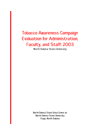 |
Companion
documents -- findings of a follow-up survey of students and
of administration, faculty, and staff aimed at evaluating the
effectiveness of a campus media campaign whose purpose was to
heighten awareness of tobacco use and secondhand smoke and promote
cessation among the campus community. |
|
|
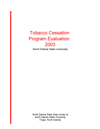 |
Tobacco
Cessation Program Evaluation: 2003, North Dakota State University
(June 2003) (.41 MB, 15pages) |
| Companion
document -- a preliminary overview of the success of the tobacco
cessation program begun in March 2003 on the campus of North
Dakota State University. |
Visual Impairment
Among North Dakotans
| |
Visual
Impairment Among North Dakotans, 2005 Report (February 2005)
(2.6 MB, 23 pages) |
|
The purpose of this report is to present estimates and projections
of the number of people ages 15 and older in North Dakota
who have a visual impairment, in 2000, 2010, and 2015. |
Wage Comparability Study for North Dakota Head Start
|
2006 Wage Comparability Study: North Dakota Head Start and Early Head Start (March 2007)
(104 KB, 20 pages) |
The purpose of this report is to provide North Dakota Head Start and Early Head Start administrators a tool for objectively evaluating the wages and salaries of their staff relative to other Head Start programs in the state. The data are based on wage and salary reports supplied by 12 Head Start and Early Head Start programs throughout North Dakota for the program year 2006. Comparable wage/salary analysis has been conducted using data from three independent sources: Job Service North Dakota, Head Start Program Information Reports, and the U.S. Bureau of Labor Statistics. |
Wishek,
North Dakota, Surveys
| |
Wishek,
North Dakota, 2005 Community Survey (October 2005) (2.13
MB, 18 pages) |
|
Perceptions among residents of Wishek, North Dakota, regarding
their vision for the community. |
 |
Wishek,
North Dakota, 2005 Leadership and Business Survey (October
2005) (.55 MB, 29 pages) |
| Perceptions
among key leaders of Wishek, North Dakota, regarding the community's
development situation. |
Women's
Way Direct Mail Project
| Women's
Way consulted with staff at the North Dakota State Data
Center to evaluate the effectiveness of direct mail in North
Dakota. The direct mail project included evaluating the success
of the direct mail campaign, examining characteristics of the
intended audience, examining the overall reliability of the
sampling frame developed from a purchased list of names, and
providing feedback for future message and campaign design. Women's
Way, the North Dakota Breast and Cervical Cancer Early
Detection Program, is administered by the North Dakota Department
of Health and funded by the Centers for Disease Control and
Prevention. The 2005 Summary and the 2005 Technical Report are
also available on the North Dakota Department of Health website
at http://www.ndhealth.gov/cancer/publications.asp?DivisionID=2. |
| |
Women's
Way Direct Mail Project: 2005 Summary (December 2005)
(184 KB, 20 pages) |
|
The results of the project are summarized in this report. |
 |
Women's
Way Direct Mail Project: 2005 Technical Report (December
2005) (1.14 MB, 128 pages) |
| Detailed
results of the project are presented in this report. |
Volume 27 - 2011
Volume 26 - 2010
Volume 25 - 2009

Volume 20 - 2011
Volume 19 - 2010
Volume 18 - 2009
|
|
Prepared tables present information from detailed data sources. These data sources are usually either very complex or are not offered to the public free-of-charge. The data are organized in a user-friendly format, but do not offer analysis and interpretation. Most tables are offered in PDF and Spreadsheet formats. When available, we link to prepared tables on the original data source websites. |
NDSDC
Prepared Tables: Census 2010 Data
| These data tables present Census 2010 data. You can also access data via the Census Bureau's American Factfinder 2 website. |
| Total Population for North Dakota Cities
by Race and Hispanic or Latino Origin: 2010 (PDF file) |
| Total Population for North Dakota Counties
by Race and Hispanic or Latino Origin: 2010 (PDF file) |
| Total Population for American Indian Reservations in North Dakota
by Race and Hispanic or Latino Origin: 2010 (PDF file) |
| Total Population and Housing Occupancy Status for North Dakota Cities: 2010 (PDF file) |
| Total Population and Housing Occupancy Status for North Dakota Counties: 2010 (PDF file) |
| Total Population and Housing Occupancy Status for American Indian Reservations in North Dakota: 2010 (PDF file) |
| Total Population for North Dakota: Census 2010 (Population Bulletin released April 2011, with historical census data - PDF) |
| North Dakota data for redistricting were released March 16, 2011. You can read about the data and see tables here (see Custom Tables on righthand side) or access the data via American Factfinder 2. Click here for Census 2010 stories at USAToday.com, including North Dakota's data. |
| Table 5: Resident Population of the 50 States, the District of Columbia, and Puerto Rico: 2010 Census and Census 2000 [on website: Excel | PDF ] |
| Apportionment Data Released 12/21/2010 |
NDSDC
Prepared Tables: Previous Census Data (through 2000)
| These data tables present Census 2000 and historical census data; most were
created to correspond to the release of Census 2000 data. |
| ND
Historical Population (PDF file) |
| Difference
in Population by Race and Hispanic or Latino Origin: 1990 and
2000 (PDF file) |
North Dakota State
Legislative Districts:
Population by Race and Hispanic or Latino Origin: 2000 (PDF or Excel file)
1990 and 2000 Population Counts, with Percent Change (PDF or Excel file) |
15 Largest Counties
and Cities in North Dakota: 1990 and 2000:
Population (PDF file)
Race
and Hispanic or Latino Origin (PDF file) |
| Total Population for North Dakota Counties
by Race and Hispanic or Latino Origin: 2000 (PDF or Excel file) |
| Population Trends for North Dakota by County: 1870-2000 (PDF or Excel file) |
| Voting Population (Persons 18 Years and
Older) of North Dakota by County, with 1990-2000 Percent Change
(PDF or Excel file) |
| Children (Persons 0 to 17 Years) in North
Dakota by County, with 1990-2000 Percent Change (PDF or Excel file) |
| Hispanic Population (of any Race) in North
Dakota by County: 1990 and 2000 (PDF or Excel file) |
| Total Population for North Dakota Cities
by Race and Hispanic or Latino Origin: 2000 (PDF or Excel file) |
| 1990-2000 Population Trends for North
Dakota Cities, with Percent Change (PDF or Excel file) |
| Total Population for North Dakota Cities:
1920 to 2000 (PDF or Excel file) |
| 2000 Population for County Subdivisions
in North Dakota with Total Population and Number of Persons
18 and Older (PDF or Excel file) |
| 2000 Population for North Dakota Counties
by Tract with Total Population and Number of Persons 18 and
Older (PDF or Excel file) |
American Indian
Reservations in North Dakota:
Population by Race and Hispanic or Latino Origin: 2000 (PDF or Excel file)
1990 and 2000 Population, with Percent Change (PDF or Excel file) |
Select
Data Links:
|
NDSDC
Prepared Tables: Previous Estimates
| These data tables are
created to correspond to the release of new population estimates. |
| Annual Population Estimates for the U.S. and States: April 1, 2010 to July 1, 2011 (website) |
| 2000s Estimates |
| Annual Population Estimates for the U.S. and States April 1, 2000 to July 1, 2009 (website) |
| Annual Estimates of the Population for Counties of North Dakota: April 1, 2000 to
July 1, 2009 (website) |
Population Estimates by North Dakota Place:
Census 2000 and July 1, 2000 to July 1, 2009 Estimate:
|
| Selected Age Groups for the United States and States: July 1, 2009 (website) |
| Total Population Estimates by 5 Year Age Cohorts in North Dakota by County: July
1, 2009 Estimates (PDF or Excel file) |
| North Dakota Estimates for Race and Hispanic Origin Through 2009 (website) |
| 1990s Estimates |
| Total Population for North Dakota by County,
1990 and 2000 Census and 1991-1999 Estimates (PDF or Excel file) |
| Population Estimates for Places (Sorted Alphabetically Within North Dakota): Annual Time Series,
July 1, 1990 to July 1, 1999 (includes April 1, 1990 Population
Estimates Base) (PDF or Excel file) |
NDSDC
Prepared Tables: Migration
| These data tables are
created to correspond to the release of new migration data. |
| Net Migration in North Dakota by County:
1950-60 to 2000-09 (PDF or Excel file) |
 |
American Indian Reservations
in North Dakota:
- Population by Race and Hispanic or Latino Origin:
2000 (PDF or Excel file)
- 1990 and 2000 Population, with Percent Change (PDF or Excel file)
|
 |
Difference
in Population by Race and Hispanic or Latino Origin: 1990
and 2000 (PDF file) |
 |
North Dakota State Legislative Districts:
- Population by Race and Hispanic or Latino Origin:
2000 (PDF or Excel file)
|
 |
15 Largest Counties and Cities
in North Dakota: 1990 and 2000
|
 |
Total Population for North Dakota
Counties by Race and Hispanic or Latino Origin: 2000 (PDF or Excel file) |
 |
Total Population for North Dakota
Cities by Race and Hispanic or Latino Origin: 2000 (PDF or Excel file) |
 |
Hispanic Population (of any Race)
in North Dakota by County: 1990 and 2000 (PDF or Excel file) |
American Indian Reservations
 |
American Indian Reservations
in North Dakota:
- Population by Race and Hispanic or Latino Origin:
2000 (PDF or Excel file)
- 1990 and 2000 Population, with Percent Change (PDF or Excel file)
|
 |
American Indian Reservations
Profiles (DP-1 through DP-4 Census 2000 Profiles from the Census Bureau):
|
State Legislative District
 |
North Dakota State Legislative Districts:
- Population by Race and Hispanic or Latino Origin:
2000 (PDF or Excel file)
- 1990 and 2000 Population Counts, with Percent Change
(PDF or Excel file)
View Maps
of Legislative Districts on North Dakota State Legislative Branch website
Census Redistricting
Data Program |
| |
Census 2000 data for North Dakota's State Legislative Districts, now available on the U.S. Census Bureau website, are organized and presented by the Missouri Census Data Center: ACCESS DATA .
Demographic profiles are available for Senate Districts 1 through 47 and House Districts 1 through 47. Profiles include 29 sections: 1) Population Basics, 2) Age, 3) Race and Hispanic, 4) Relationship of Persons in Households, 5) Households by Type, 6) Marital Status, 7) Language Spoken at Home, 8) Foreign Born Persons, 9) Residence in 1995, 10) Place of Work, 11) Commuting, 12) School Enrollment, 13) Educational Attainment, 14) Veteran and Armed Forces Status, 15) Disability, 16) Employment Status, 17) Work Force by Industry, 18) Work Force by Occupation, 19) Household Income in 1999, 20) Income Percentages by Source, 21) Other Income Measures, 22) Poverty, 23) Miscellaneous Population, 24) Housing Unit Basics, 25) Selected Housing Characteristics, 26) Units in Structure, 27) Age of Structure, 28) Gross Rents, and 29) Housing Values.
Access State
Legislative District Outline Maps for North Dakota by county (each
county has a separate directory with one PDF file per map
sheet) on the Census Bureau's web site (tips for viewing
and printing PDF Map Files) |
City/Place,
Township, Tract
County
State
|

